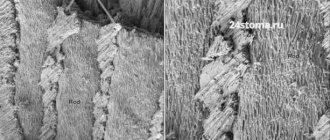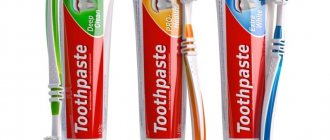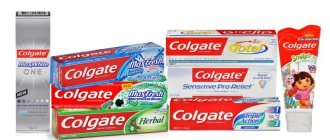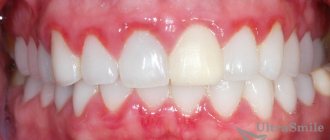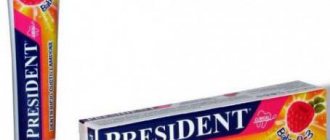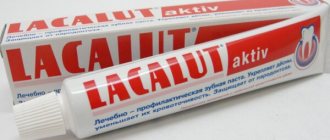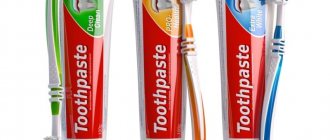What role does fluoride play in our body?
When answering the question of what fluorine is and why it is needed, it should immediately be explained that in its pure form this element is a rather poisonous and toxic gas. However, in products and hygiene products this substance is contained in the form of salts - sodium or calcium fluoride. In this form, it can bring tangible benefits to the body.
Our need for this element is no more than three milligrams per day.
So, what does fluoride do in toothpaste and why is it needed? First of all, it supports the natural mineralization of bone tissue, making it strong and at the same time elastic. Sufficient intake of this substance into the body promotes the growth of nails and hair, strengthening of dental tissues. In addition, it provides additional protection for the body from the effects of pathogenic microflora, improves immunity, and helps eliminate toxins and heavy metals.
Fluorides in toothpaste: to be or not to be (caries)?
A toothpaste is considered good when it not only gently cleanses the teeth, but also protects them from caries. To prevent caries, toothpastes usually contain fluoride compounds - fluorides. At the same time, many consider them to be the purest poison - on the Russian market you can find pastes marked “fluoride-free”, and on European samples, for example, we see “fluoride-free”. What to do about caries? LookBio and ekokosmetika.ru checked the facts.
Let's talk in terms
Fluorine (engl: Fluorine) is a chemical element, reactive and poisonous gas. Fluorine salts are called fluorides, they are found everywhere in nature, in food products, for example, fish, black tea, mineral water. Fluorides are also found in the human body - in bones and teeth.
Fluorides are known for their ability to prevent tooth decay, which is why they can be found in most toothpastes. The most commonly used fluorine compounds in pastes are:
Sodium fluoride Potassium Fluoride Stannous Fluoride Aminofluoride/Olaflur Sodium monofluorophosphate Calcium fluoride
Decades of fluoride use in toothpastes and a corresponding reduction in dental caries in the population demonstrate the effectiveness of fluoride in the fight against dental caries. In some countries, such as the USA and Canada, fluorides are added to drinking water and table salt with fluorides can be found on sale.
Here it is worth saying why we insist on the correct use of terms and we ourselves will not speak incorrectly. The fact is that the combination “toothpaste without fluoride” or “fluoride in toothpaste”—precisely such formulations are found on dental hygiene products on the Russian market or in incriminating articles on the Internet—is incorrect both from a chemical and linguistic point of view. Why fluorides “went to the people” in the form of fluoride is known reliably only to the tooth fairy. Fluorine, a reactive and poisonous gas, is not present in the paste in its pure form, but it is its compounds, fluorine ions - fluorides.
Effect of fluoride in toothpaste
Bacteria in the oral flora break down sugars from food into acids. These acids strip minerals from tooth enamel. Saliva in the mouth is responsible for replenishing the required level of minerals, but with excessive sugar consumption, saliva can no longer cope with its task. This is where toothpaste with fluoride comes to the rescue, which forms a protective film on the teeth, reducing the formation of acid in the oral cavity and thus stabilizing the minerals in the tooth enamel. Fluorides also help calcium phosphates found in saliva penetrate tooth enamel more quickly. All this only works when we brush our teeth. Therefore, regular brushing of teeth with fluoride paste should keep teeth healthy and fight tooth decay. This is exactly what the recommendations of most dentists around the world sound like.
From benefit to harm
Fluorides are classified as toxic substances - excess amounts entering the body, especially over a long period, can cause significant harm. That is why there are restrictions on the percentage of fluoride compounds added to children's and adult toothpaste. For example, in the European Union and the United States, the amount of fluoride in toothpaste must be indicated on the packaging in the form “ppm F” (parts per million). Fluorides may be listed in the list of active ingredients or in the general list of toothpaste ingredients. According to the EU Directive (EU Directive 76/768/EEC), a cosmetic product (including toothpaste) cannot be marketed if the amount of fluoride in it exceeds 1500 ppm F. Modern toothpastes for adults sold in the EU contain from 1000-1500 ppm F. In this case, the packaging must contain o. Children's toothpastes with fluoride should state "for children under 6 years of age: use a small amount of toothpaste." Because children often partially swallow toothpaste, children's toothpastes are either fluoride-free or limited to 250-500 ppm. It is also recommended to make baby toothpastes with fluoride without a sweet taste, which provokes the swallowing of the toothpaste.
In Russia, restrictions on the amount of fluoride in toothpaste also exist. They are regulated by the Technical Regulations of the Customs Union TR CU 009/2011 “On the safety of perfumery and cosmetic products” and amount to 0.15% in terms of fluorine. Therefore, if 10000ppm=1%, then the European 1500 ppm is “our” 0.15%.
Excessive concentrations of fluoride in dental care or frequent intake of liquids, foods or medications containing fluoride compounds can cause dental fluorosis, which is characterized by changes in the enamel, leading to the loss of its natural color and the appearance of chalky, yellow and dark streaks on the teeth. Long-term overdose of fluoride can lead to bone fluorosis, kidney problems, etc.
However, adults who brush their teeth twice daily with fluoride toothpaste have little to worry about, even if they also consume table salt with fluoride. The vast majority of experts today believe that fluoride in toothpaste is the best prevention of caries, and acceptable standards in dental hygiene products do not pose a health hazard.
Yes, theoretically, if a child swallows a full tube of adult toothpaste with fluoride, he will be poisoned. In any case, if parents have doubts about an overdose, they should contact their pediatrician.
Fluorides in certified natural cosmetics
Natural certifications such as COSMOS (BDIH, Soil Association, ICEA, Cosmebio, Ecocert) and NaTrue allow the use of fluoride in toothpaste. However, most manufacturers and consumers of natural and organic cosmetics are anti-fluoride: they believe in preventing tooth decay through healthy saliva and proper teeth cleaning, believing that potentially toxic fluorides have no place in the mouth (and body) even in minimal quantities. Because of these beliefs, eco-certified toothpastes for adults and children contain other ingredients to prevent tooth decay. These can be various herbal extracts or xylitol. However, to date, there is no reliable scientific research that xylitol (without fluoride) in toothpaste is effective in preventing caries.
German manufacturers of natural cosmetics are now expanding their lines of dental care products by adding fluoride pastes to their range. The fact is that in product tests (for example, in the popular German magazine Oekotest), which consumers trust, toothpastes without fluoride often fall into the last lines of the ratings.
Carefully! Quackery in RuNet
Serious studies that could prove the harm of fluorides are currently difficult. At the same time, you can find sites on the Internet that expose fluorides from all sides and greatly exaggerate their danger and level of toxicity. As a rule, sites created in the commercial interests of manufacturers of some “healthy alternative” to toothpastes with fluoride are intimidated with such information. When looking for information about the dangers of fluoride, please pay attention to the reliability of the source and the presence of links to scientific studies and original data.
conclusions
- Fluorides in toothpastes are recognized as an effective modern means for caries prevention.
- The presence of caries can also be caused by poor oral hygiene, nutritional deficiencies and health problems.
- Yes, fluoride is toxic, but not in the amount found in toothpaste.
- If you can eliminate sugar completely, you can also eliminate fluoride toothpastes.
- For oral hygiene in children, only pastes without fluorides or with a reduced fluoride content are acceptable.
- Whether your toothpaste will contain fluorides or not is a matter of personal choice.
- It is correct to say “fluoride-free toothpaste” rather than “fluoride-free toothpaste.”
Sources:
Griffin SO, Regnier E, Griffin PM, Huntley V (2007). "Effectiveness of fluoride in preventing caries in adults". J.Dent. Res. 86 (5):410–5 https://www.ncbi.nlm.nih.gov/pubmed/17452559
Kanduti D, Sterbenk P, Artnik B “FLUORIDE: A REVIEW OF USE AND EFFECTS ON HEALTH Mater Sociomed. 2016 Apr; 28(2): 133–137. https://www.ncbi.nlm.nih.gov/pmc/articles/PMC4851520/
Malinowska E, Inkielewicz I, Czarnowski W, Szefer P (2008). "Assessment of fluoride concentration and daily intake by human from tea and herbal infusions." Food Chem. Toxicol. 46(3): 1055–61. doi:10.1016/j.fct.2007.10.039. PMID 18078704.
National Health and Medical Research Council (Australia) (2007). A systematic review of the efficacy and safety of fluoridation (PDF). ISBN 1-86496-415-4. Summary: Yeung CA (2008). "A systematic review of the efficacy and safety of fluoridation". Evid. Based Dent. 9 (2): 39–43. doi:10.1038/sj.ebd.6400578. PMID 18584000. Lay summary (PDF) – NHMRC(2007)
Bashash M, Thomas D, Hu H, Martinez-Mier EA, Sanchez BN, Basu N, et al. Prenatal fluoride exposure and cognitive outcomes in children at 4 and 6-12 years of age in Mexico. Environ Health Perspective. 2017;125(9):097017. Available from: https://ehp.niehs.nih.gov/ehp655/
Why is this component so important for dental health - the benefits of the substance
The content of this element in oral care products protects against caries, makes enamel stronger, effectively removes plaque and fights pathogenic microflora. Let's take a closer look at the undoubted advantages of this component.
Prevention of caries
The enamel is constantly exposed to aggressive acids that are released with saliva. Food remains and other external factors lead to the formation of plaque, which gradually transforms into hard dental deposits, leading to the destruction of the enamel layer. As a result, a white spot first appears, which darkens and turns into a carious cavity.
The photo shows caries at the spot stage
Fluorine penetrates the crystal lattice of enamel, strengthens it and increases resistance to pathogenic microorganisms. It provides prevention of caries and prevents its further development, even if the disease is already at the white spot stage.
Decalcification protection
The substance promotes a process called “remyelination” - the transition of ions from the blood to the body’s tissues. Saliva, which is produced during food intake, leads to the opposite effect, that is, loss of calcium from dental tissues. When calcium and fluoride ions enter the oral cavity, they penetrate the crystal lattice of the enamel, strengthening it and preventing the destruction of hard tissues under the influence of saliva.
Strengthening enamel
The basis of enamel is calcium hydroxyapatite. By interacting with the microelement in question, this salt is converted into a new substance - fluorine hydroxyapatite. Thus, the microelement in question acts as a calcium protector, protecting it from the aggressive effects of acids in the oral cavity.
Prevention of the growth of pathogenic microflora
Pathogenic microorganisms that form plaque secrete special enzymes necessary for the breakdown of carbohydrates and their absorption. Our substance blocks the production of these enzymes, which prevents the further spread of pathogenic microflora.
Fluoride works great against plaque
“I have been using fluoride toothpaste for a year now and am very pleased with the results! About six months ago I bought myself an irrigator, so with them, every morning cleaning feels like after professional hygiene at the dentist. I recently had a preventive examination and there were no problems with the enamel. And I myself understand that sensitivity has not appeared, the teeth are white, without spots or irregularities. It seems to me personally that all this hysteria about the harm of such products is greatly exaggerated!”
AlesyaK., Moscow, from correspondence on the woman.ru forum
Stopping the secretion of lactic acid
This microelement blocks excess lactic acid synthesis, thereby effectively suppressing the growth of pathogenic microflora. This acid is produced by microorganisms during their life and reproduction. Products containing this component prevent this process, thereby providing additional protection for the enamel.
Harm of triclosan to the body
It has been proven that triclosan, when entering the body, has a number of undesirable effects on various organs and systems.
Hormonal imbalance
The substance, once on the skin as part of creams and ointments, easily passes through the skin barrier, as it is a fat-soluble substance. It enters the bloodstream and behaves like the female sex hormone estrogen. This replacement therapy disrupts hormonal levels and leads to gonadal cancer in men and women. Children may experience early puberty.
Thyroid dysfunction
Triclosan metabolic products interfere with the normal functioning of the thyroid gland. This gland regulates all types of metabolism, is responsible for the formation of energy and the proper development of the body.
Development of heart and vascular diseases
The component changes the contractility of muscle fibers, including the main muscle in the body - the heart.
Destruction of beneficial microflora
The component affects both pathogenic forms and resident microflora of the body. Beneficial bacteria, necessary for a balanced internal environment, die from the action of the substance.
Weakened immune system
To form a strong immune system, the body needs to deal with natural “dirt.” The immune system will then activate its defense systems and produce antibodies. People who have been using personal hygiene products with antibacterial components since childhood are more susceptible to infectious diseases, since their immunity does not develop sufficient resistance to environmental factors.
With prolonged exposure to a substance, pathogenic bacteria develop resistance, or tolerance, to the substance. When an infectious disease develops in the body, the treatment of which requires antibiotics, microorganisms may exhibit the same resistance, and therapy will be ineffective.
Harm to fetal development
According to some studies, triclosan negatively affects the health of the fetus in the womb. It reduces blood flow to the fetal brain, which leads to oxygen deficiency of the organ, and this leads to a disruption in its development.
Poisoning of the body
When interacting with tap water, the substance combines with chlorine. As a result, special compounds are formed - dioxides, which are absorbed into the blood and have a toxic effect on the body.
In addition to its direct effect on the human body, triclosan, when released into the environment with water, pollutes water bodies and soil, and poisons plants and animals.
In Russia you can easily purchase products containing this substance. However, in 2016, US authorities issued a ban on the sale of soap containing triclosan as an antibacterial component. The ban does not apply to other products, including pastes.
What types of pastes with fluoride compounds are there?
Products that contain this component are usually classified as therapeutic and prophylactic. If the concentration is insignificant, then the product will be considered hygienic. Different salts of this component can be presented in different forms: amino fluorides, sodium fluorides, sodium monofluorophosphates and others. Pastes with a high content of the substance are recommended for use in courses.
Such pastes are usually therapeutic and prophylactic
As for the question of which toothpaste does not contain fluoride, the range of possible alternatives is less diverse. Products that do not contain fluoride usually contain other active ingredients, which are also characterized by their own advantages and disadvantages.
Children's toothpastes with fluoride
Children's toothpastes should absolutely not contain fluoride, despite the fact that this element is necessary for growing organisms. Fluoride is added only to toothpastes for children and adolescents over 5 years of age. The thing is that young organisms perceive various components much more strongly and are many times more susceptible to fluorosis (excess fluoride).
So, now you know the benefits and harms of fluoride in toothpastes. You should not decide on the use of such means on your own. Only an experienced dentist should prescribe pastes with fluoride and calcium.
To avoid the need for medicinal pastes, take good care of your teeth and be attentive to your body. Do not get carried away with coloring products, coffee, tea and sweets. For dental health, the absence of bad habits, proper, balanced nutrition and daily thorough hygiene procedures are important.
An excellent tooth support product is ASEPTA “Remineralization” professional toothpaste with high concentrations of hydroxyapatite and thermal mud. This remedy restores tooth enamel, reduces the sensitivity of teeth and gums and accelerates the regeneration of the oral mucosa.
Can it be used by children?
When choosing a product for children's teeth, it is important to assess the possible risks - whether it will bring more benefit or harm in your particular case. And to do this, you should first show your child to the dentist and consult with him about purchasing the most suitable toothpaste.
You should also take into account that most young children swallow part of the paste during brushing, and this can cause undesirable consequences, including stomach and intestinal upset. So, the concentration of the component should not exceed 1500 ppm1 - this is how this indicator will be indicated on the packaging, indicating how much of the substance is contained in this paste.
For a child, you need to choose only children's toothpaste
However, modern manufacturers also produce fairly effective and safe fluoride products for children, which provide excellent prevention of childhood caries. But it can only be used in courses and according to the indications of a pediatric dentist.
What is triclosan?
The component was first synthesized in Swiss laboratories more than 40 years ago.
This is a substance of chlorine-phenolic nature, which has been used as an antibacterial component in personal hygiene products and household chemicals. It was also used as an agricultural pesticide to kill pests. For many years, research and debate have been ongoing about how dangerous the component is for humans.
The substance has antibacterial properties. The spectrum of its antimicrobial activity is extremely wide; the effectiveness of the substance has been confirmed by many years of use in dozens of different products. Triclosan is well compatible with other components of hygiene products, including pastes, so the choice of many manufacturers fell on this substance.
The effectiveness of the component is confirmed even when used in low concentrations. It destroys bacteria and fungi, has a bacteriostatic and bactericidal effect, influencing the configuration of the cytoplasmic membranes of microorganisms. The substance does not cause a response formation of colonies of microbes that can resist the effects of the antiseptic. Its negative property is that it also destroys the beneficial microflora that makes up the natural environment of the human body.
What harm could it do?
Fluoride is found not only in hygiene products, but also in food and even tap water. The acceptable daily intake is approximately 3 mg. But in certain regions and localities, the content of the substance in running water greatly exceeds the norm, which can lead to an overdose of this microelement, especially in children.
So, why is it considered that such pastes are harmful, and why is an excess of this substance dangerous? Let's start with the fact that the element in question is characterized by toxicity and the ability to accumulate in tissues, including tooth enamel - this is one of the reasons why such products cannot be used constantly.
When this happens, a pathology called fluorosis develops. White spots appear on the teeth, after which they become noticeably darker, literally corroding hard tissue. This condition requires treatment by a dentist. In such cases, specialists usually prescribe remineralization and fluoridation, as well as the use of special hygiene products that help restore damaged tissue.
An excess of the substance in the body can cause fluorosis
Are fluoride toothpastes harmful?
In addition to being found in oral hygiene products, fluoride is found in water and some foods. In some regions of the country, there is an excess of the substance in tap water, which can cause an overdose, which is especially dangerous for children. Since fluoride is toxic and can accumulate in tissues, including tooth enamel, for these reasons it is not recommended to use products with it all the time. An excess of fluoride in medicine is called fluorosis. Stains form on the tooth surface, which darken over time and corrode hard tissues. This phenomenon requires specialist intervention. In such situations, dentists make appropriate appointments, which include a remineralization procedure. You will also have to switch to special oral care products that will facilitate the rapid restoration of damaged tissue.
Substance poisoning - symptoms
A sufficient, but not excessive intake of this substance into the body helps strengthen the enamel and improve the condition of the teeth. However, overdose can cause serious damage. Usually in such cases they talk about the development of fluorosis. Among the most common varieties of this pathology, experts in the field of dentistry distinguish spotted, streaked, chalky-speckled, erosive and destructive forms. Let's look at them in a little more detail:
- spotted - involves the formation of small light spots on the enamel, which can merge with each other, forming one large spot,
- streaked - light stripes of different shapes appear on the incisors, which can also combine to form fairly large strokes,
- chalky-mottled - the surface of the teeth becomes dull and yellowish, while many dots and specks appear on its surface. Pathological abrasion of the enamel is noted, due to which the dark color of dentin begins to appear,
- erosive – leads to the formation of numerous specks, but primarily affects the chewing surface of the teeth,
- destructive – dental tissues become fragile and quickly break down.
The photo shows dental fluorosis.
An excess of fluoride in the body also affects the condition of the skeletal system. One possible complication is osteoporosis, in which the bones become soft and calcium is quickly washed out of them. Pathological changes occur in the joints, causing ankylosis to develop. In advanced cases, the liver and kidneys suffer.
How to remove excess substance from the body
There are methods that allow you to remove excess fluoride from the body, but they give the desired result only if the pathology is in the initial stages of its development. Here are the main ways to combat intoxication with this element:
- iodine – promotes the excretion of the substance in the urine, so it is recommended to increase the consumption of foods rich in this component: strawberries, lingonberries, beans, potatoes,
- boron – also effectively removes fluoride and is found in high concentrations in honey, nuts, dates, avocados, prunes,
- selenium – blocks the activity of an excess element, found in sufficient quantities in Brazil nuts,
- dry sauna – helps remove accumulated toxic substances through sweating.
Consumption of iodine-containing products helps remove the substance from the body.
But before moving on to measures to remove the substance, it is necessary to limit its entry into the body. For a while, you will have to give up foods with a high content of it, switch to clean bottled water, and stop using fluoride-containing hygiene products.
HOW TO PROTECT YOUR BODY FROM THE EXPOSURE OF FLUORIDE WHEN BRUSHING YOUR TEETH
To ensure that active fluoride ions do not cause harm to the body, you must adhere to a few simple rules:
- Study the packaging of the toothpaste when purchasing, pay attention to which fluoride compound is included in its composition and in what concentration.
- Before using a fluoridated product, you should consult with a specialist ; perhaps the level of fluoride in the water in the region where you live is sufficient and such a paste will only cause harm.
- Children under 6 years of age should not use fluoridated toothpaste . At this age, children do not fully have the skills to brush their teeth, which can cause them to swallow large amounts of hygiene products.
- When planning a vacation in other regions, you should pay attention to the level of natural fluoride content in drinking water. If the content is normal or high, you should stop using fluoridated toothpastes during the rest period.
- To minimize the amount of fluoride that enters the body when brushing your teeth, the amount of toothpaste should not exceed the size of a small pea.
In addition to pastes, fluoride is included in rinses, special gels and chewing strips, as well as dental preparations that are used in a professional office. Therefore, the choice of a method for preventing the development of caries should be left to the dentist and strictly adhere to all his recommendations.
Source
Tips for choosing dental hygiene products
In order for daily cleaning to be as effective as possible, you need to carefully consider the choice of toothpaste. It is best to consult your dentist in this matter and give preference to the product that is most suitable for your specific case. All toothpastes on the market can be divided into three independent categories:
- hygienic – used for daily cleansing of enamel and aromatization of breath,
- medicinal – they contain active additives that, when interacting with damaged or inflamed tissues of the oral cavity, help stop pathological processes,
- therapeutic and prophylactic - also contain active components, but in lower concentrations, prevent the development of many dental diseases - teeth and periodontal tissues.
When choosing a toothpaste, carefully study its composition. You need to
choose which toothpastes contain fluoride, or give preference to a product without this component, taking into account the current condition of the teeth and oral cavity. The dentist will help you with this after examining and assessing the current condition of the enamel.
Types of pastes
According to dentists, the best paste is the one that fully meets the needs of a particular person. Modern manufacturers have significantly expanded the range of their products. And now it is not just a means for cleansing plaque, but also an indispensable assistant in the fight against inflammatory processes, increased sensitivity of enamel, initial carious processes and many other problems. This is unconditional progress, but along with it another problem has appeared: an incorrectly selected product may not only not bring the desired result, but also cause harm.
But first, let's discuss the types of pastes. According to GOST 7983-99, all toothpastes are divided into:
- hygienic,
- therapeutic and prophylactic.
Hygienic pastes are designed for mechanical removal of food debris and plaque from enamel. They contain no drugs.
Therapeutic and prophylactic pastes are intended for the prevention of various oral diseases: caries, gingivitis, periodontal disease. Such pastes have antiseptic and anti-inflammatory effects.
Rating of the best products containing fluoride
Today on pharmacy shelves you can find a wide variety of different brands of dental and oral hygiene products. Let's take a closer look at which pastes contain this substance and are considered the most popular in their segment.
Paradontax for healthy teeth and gums
According to the manufacturer, the paste helps restore gums and reduce signs of inflammation and bleeding. The presence of fluoride in its composition ensures high-quality plaque removal and caries prevention. According to reviews, within just a few days of using Paradontax, gums acquire a healthy pink tint, and teeth become noticeably whiter.
Colgate for caries protection
One of the most popular companies today that produces various hygiene products to keep the oral cavity clean and healthy. Fluoride paste helps prevent the development of caries in the initial stages, effectively remove plaque and prevent stone formation.
Blend-a-med with active fluorine in its composition
This option is optimal in terms of price and quality ratio. The product is affordable and quite effective - it successfully removes plaque, eliminates unpleasant odor, and prevents gum inflammation. You need to understand that using a paste for daily use is unlikely to achieve a perfectly snow-white smile, but it will definitely help with plaque and bacteria.
Sensodyne against hypersensitivity
This remedy effectively combats hyperesthesia - increased sensitivity of enamel, especially during temperature changes and mechanical irritation. In addition, it perfectly fights the first signs of caries. Before you start using any product that contains high fluoride, it is best to talk to your dentist. Constant use of such pastes is undesirable.
The best fluoride-free toothpastes
The use of toothpastes without fluoride is important in those regions where its content in water is high (more than 1 mg per liter). In Russia, such regions are located in the Moscow, Tambov, Tver regions, in Siberia and the Urals. The packaging of such a paste should not contain the following names: olaflur (aminofluoride), tin fluoride, aluminum fluoride, sodium fluoride, monofluorophosphate.
The first place in the ranking among fluoride-free toothpastes is occupied by Splat toothpastes
The Russian company produces two types of pastes that do not contain fluorine compounds - Splat-biocalcium and Splat-maximum, both deservedly occupy first place in the ranking.
Splat paste – biocalcium
Rating: 10.0
The paste contains calcium lactate, hydroxyapatite, polydone and papain. Calcium compounds provide remineralization of enamel, and polydon and papain dissolve plaque on the teeth, facilitating its easy removal. The effectiveness of hydroxyapatite paste depends on the particle size. The smaller their size, the faster and deeper they penetrate into the tooth tissue. The manufacturer claims that fine particles are used to make this paste, and we have no reason not to believe his words.
Splat-maximum paste
Rating: 10.0
In addition to the components of the previous paste, Splat-maximum includes licorice extract, zinc citrate and an enzyme complex. Hydroxyapatite penetrates into tooth tissue, promoting their remineralization and enzymes. Polydon and papain destroy plaque, zinc citrate provides freshness in the mouth.
Second place in the ranking - President unigue pasta
Rating: 9.5
Includes three compounds: pantetonate, calcium lactate and glycerophosphate, which ensure easy absorption of calcium by tooth enamel. Papain ensures the dissolution of dental plaque, and xylitol inhibits its formation and neutralizes the acidic environment of the oral cavity. One of the disadvantages is the content of potassium salt, which reduces the sensitivity of the enamel. The use of pastes with this effect is recommended for hypersensitivity as a course of treatment. Since daily use can lead to a decrease in the sensitivity of nerve endings and hide the first symptoms of caries.
Third place in the ranking - ROKS paste for adults
Rating: 9.0
This paste is produced by a Russian company and contains calcium glycerophosphate, bromelain, xylitol. Bromelain dissolves plaque, xylitol prevents the development of caries, having an effect that inhibits the growth rate of bacteria, neutralizing the acidic environment. Calcium glycerophosphate mineralizes enamel. A big plus is the variety of flavors to choose from (more than 10). The abrasiveness does not exceed the norm for daily use. The big disadvantage is the high price.
How to brush your teeth correctly
Choosing the right toothpaste is only half the battle. To achieve a visible and tangible effect, it is important to learn how to properly carry out daily cleaning. Let us remind you that the main rule of maintaining oral hygiene is regular cleaning of the enamel with a brush and paste. As for the technique of its implementation, experts in the field of dentistry provide several more important recommendations in this regard:
- from the outside, the teeth must be cleaned with vertical sweeping movements, starting from the gums (if you brush in a horizontal direction, you can damage the enamel),
- similar vertical movements should be used to clean the inner surface,
- posterior molars can be cleaned using horizontal movements, paying special attention to the chewing surface,
- Next, you should move on to the tongue - its surface must be cleaned, since it is on it that the largest number of bacteria accumulate.
It is better to learn the correct cleaning technique from childhood. This is one of the reasons why, after the appearance of the child’s first teeth, it is imperative to show him to the dentist for preventive care. Even if you are not sure as an adult that you brush your teeth correctly, a professional dentist will definitely help you with this.
Choosing a brush - expert advice
Another mandatory attribute of daily oral care is a brush. Her choice also needs to be taken seriously, and dentists give the following advice on this matter:
- the head should not exceed 3 cm in length,
- it is better to choose models with artificial bristles, since natural ones create favorable conditions for the growth of bacteria,
- The ribbed back surface of the head is designed to clean the tongue - there is no need to additionally purchase a special scraper.
It is important to choose the right toothbrush.
If you have sensitive gums that are prone to inflammation and bleeding, it is better to give preference to a brush with soft bristles. But keep in mind that it will be worse at cleaning the enamel from plaque, so the procedure must be especially intense. Hard brushes are intended to be used according to indications - otherwise they can injure the gums and enamel and do more harm than good.
Additional oral care tips
Even with systematic brushing of teeth twice a day and regular rinsing after meals, any dental problems cannot be completely ruled out. To further protect yourself from caries and other troubles, it is better to limit the consumption of sweets and carbonated drinks, coffee and smoking - all of these are the main provocateurs of pathological processes in the oral cavity.
Try to give up bad habits
You must remember to use fossa threads, and also visit the dentist’s office regularly - at least twice a year. If you notice suspicious symptoms, you should immediately consult a doctor - this is the only way to detect any problem in its very beginnings, and therefore quickly resolve it.
- According to WHO.

